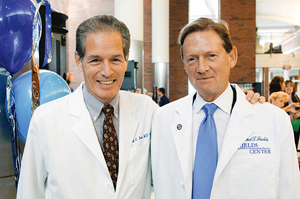

Medical Research
New Center Takes Aim at Muscular Dystrophy
A new Rochester center will provide the first international clinical and research effort aimed at finding treatments for people with one of the more common forms of muscular dystrophy. Known as facioscapulohumeral dystrophy (FSHD), the genetically based disease currently has no cure.
A “center without walls,” the Fields Center for FSHD and Neuromuscular Research is a partnership between two of the world’s leading institutions in the area of neuromuscular disease research: the University’s Neuromuscular Disease Center and Leiden Medical Center in the Netherlands. The Fields Center is funded by a $7.1 million gift from New York developer and philanthropist Richard Fields.

NAMESAKE: The first international effort aimed at finding treatments for a form of muscular dystrophy, a new research center at the University has been named in recognition of real estate developer Richard Fields (right), shown here with Medical Center CEO Bradford Berk.
The gift—the largest private donation for a specific disease program in the Medical Center’s history—provides long-term, uninterrupted funding to accelerate what has generally been an uncoordinated and fragmented research effort. It will also support clinical programs that will make the University a national referral center for patients with the disease.
“Our scientists strongly believe that new breakthroughs are within our grasp, and Richard’s support will help catalyze their efforts,” says Bradford Berk ’81M (MD/PhD), CEO of the Medical Center.
Fields is the chairman and founder of Coastal Development, which codeveloped the Seminole Hard Rock Casino and Hotel resorts in Tampa and Hollywood, Fla. Fields also serves on the board of the National Center for Missing and Exploited Children and Farm Aid, which supports family farms.
“I have a personal family connection to FSHD, so I know the impact it has on families throughout the United States and the world,” says Fields. “Rochester has long been a leader in muscular dystrophy research, so they were a natural fit to establish a center to focus on genetic and clinical research to FSHD patients.”
The center will benefit from many of the University’s existing neuromuscular programs, including the Paul Wellstone Muscular Dystrophy Cooperative Research Center and the Muscle Study Group, an international consortium focused on developing new treatments for neuromuscular disease. These networks will enable the Fields Center to recruit international scientists and clinicians to both collaborate on FSHD research and quickly move new discoveries into clinical trials.
The University also houses the National Registry of Myotonic Dystrophy and FSHD Patients and Family Members. The registry—which is funded by the National Institutes of Health—will put Fields Center researchers in touch with a large number of patients who can be recruited for research projects.
While researchers seek out new ways to treat and perhaps even cure the disease, the Fields Center will also develop clinical programs that will establish the Medical Center as a national destination for FSHD patients. Currently, the symptoms of the disease are managed through a combination of physical therapy, bracing, and in some cases, surgery. The Medical Center will develop new standards of care for the diagnosis and management of patients with FSHD.
“This is a very difficult disease to figure out in terms of what is going on,” says neurologist Rabi Tawil, director of the Fields Center. “Research has been hampered by the fact that there are very few centers involved and centers that are don’t have access to patients and patient resources necessary to move research forward.”
